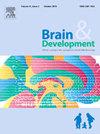Clinical characteristics and radiological features of tubulinopathy: A single-center retrospective study in Japan
IF 1.4
4区 医学
Q4 CLINICAL NEUROLOGY
引用次数: 0
Abstract
Background
Tubulin plays an important role in cell morphogenesis and chromosomal segregation. Tubulinopathies are caused by pathogenic TUBA1A, TUBB2A, TUBB2B, TUBB3, TUBB4A, TUBB, and TUBG1 variants. Although radiological features and genotype–phenotype correlations of tubulinopathy have been described, clinical severity by genotype has not been described in detail. Herein, we discuss the correlations between the clinical and radiological features of head MRI of patients with tubulinopathy and its clinical severity by genotype.
Methods
We retrospectively reviewed medical records of patients diagnosed as having tubulinopathy at our hospital between January 2000 and May 2022.
Results
Twelve (5 male, 7 female) patients were diagnosed with tubulinopathy: four with the TUBA1A variant, one with the TUBB2B variant, three with the TUBB3 variant, one with the TUBB variant, and three with the TUBB4A variant. All patients exhibited psychomotor delay; patients with perisylvian polymicrogyria-like cortical dysplasia had milder symptoms than those with generalized cortical dysplasia. Eight patients with epilepsy had good response to anti-seizure medications. Head MRI of all patients with TUBA1A, TUBB2B, TUBB3, and TUBB variants revealed basal ganglia dysplasia. All patients with the TUBB4A variant had cerebral white matter atrophy and delayed myelination, which were not found in patients with other variants.
Conclusions
The severity of psychomotor delay in patients with tubulinopathy may be related to the degree and extent of cortical dysplasia. Asymmetric basal ganglia dysplasia is a specific MRI finding of tubulinopathy. The clinical features and MRI findings associated with the TUBB4A variant differ from those of other tubulinopathies.
日本小管病的临床特征和影像学特征:一项单中心回顾性研究
微管蛋白在细胞形态发生和染色体分离中起着重要作用。微管病变是由致病性TUBA1A、TUBB2A、TUBB2B、TUBB3、TUBB4A、TUBB和TUBG1变异引起的。虽然已经描述了小管病的放射学特征和基因型-表型相关性,但基因型的临床严重程度尚未详细描述。在此,我们讨论了小管病患者的临床和放射学特征与基因型的临床严重程度的相关性。方法回顾性分析我院2000年1月至2022年5月诊断为小管病的患者病历。结果12例患者(男5例,女7例)被诊断为小管病变:4例为TUBA1A变异,1例为TUBB2B变异,3例为TUBB3变异,1例为TUBB变异,3例为TUBB4A变异。所有患者均表现为精神运动迟缓;perisylvian型多小回样皮质发育不良患者的症状较全身性皮质发育不良患者轻。8例癫痫患者抗癫痫药物反应良好。所有TUBA1A、TUBB2B、TUBB3和TUBB变异体患者的头部MRI显示基底神经节发育不良。所有TUBB4A变异体患者均出现脑白质萎缩和髓鞘形成延迟,而其他变异体患者未发现这一现象。结论小管病患者精神运动延迟的严重程度可能与皮质发育不良的程度和程度有关。不对称基底神经节发育不良是小管病的特殊MRI表现。与TUBB4A变异相关的临床特征和MRI表现不同于其他小管病变。
本文章由计算机程序翻译,如有差异,请以英文原文为准。
求助全文
约1分钟内获得全文
求助全文
来源期刊

Brain & Development
医学-临床神经学
CiteScore
3.60
自引率
0.00%
发文量
153
审稿时长
50 days
期刊介绍:
Brain and Development (ISSN 0387-7604) is the Official Journal of the Japanese Society of Child Neurology, and is aimed to promote clinical child neurology and developmental neuroscience.
The journal is devoted to publishing Review Articles, Full Length Original Papers, Case Reports and Letters to the Editor in the field of Child Neurology and related sciences. Proceedings of meetings, and professional announcements will be published at the Editor''s discretion. Letters concerning articles published in Brain and Development and other relevant issues are also welcome.
 求助内容:
求助内容: 应助结果提醒方式:
应助结果提醒方式:


